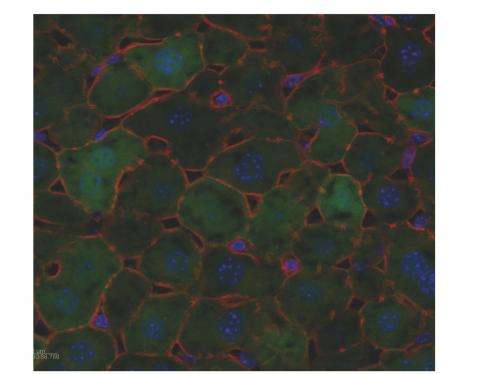How viruses can overwhelm the liver's defences

(Medical Xpress)—The liver is the only organ in the body that can modify our immune response. This, paradoxically, leaves it open to violent immune attack.
Researchers at Sydney's Centenary Institute and the University of Sydney have now discovered the means by which this happens. In the process they may have opened a pathway towards improving treatment of chronic hepatitis.
The key is in the way the immune system's T cells operate in the liver.
The researchers found that when the liver T cells encounter a small number of cells making a foreign protein, they function in the normal way—stimulating the production of cells to kill off the source of the protein.
But when they encounter large amounts of foreign protein beyond a certain threshold, the T cells are overwhelmed and fail. This weakening of the defence system is the Achilles heel of the liver, making it more susceptible to invasion by viruses that replicate rapidly and produce large amounts of protein.
"That's what we think happens when a virus such as hepatitis B or C invades the liver," says Dr Patrick Bertolino, co-head with Dr David Bowen of Centenary's Liver Immunology Research Group. "The viruses multiply very fast, spreading to many liver cells, and in doing so they force a high proportion of them to make huge amounts of protein."
If this process could be slowed or delayed on initial infection, the researchers believe that the immune system would have a much better chance of clearing the virus – as it already does in about 30 per cent of cases of hepatitis C.
Their work, which was undertaken in collaboration with the Children's Medical Research Institute at the Westmead Hospital, has just been published online in the Proceedings of the National Academy of Sciences.
In earlier studies, the Centenary research team found that the liver is the only place in the body outside of the lymph nodes with the capacity to activate T cells. But, in contrast to the lymph nodes, the T cells activated by the liver do not function efficiently and most of them are eliminated. By this means, the liver can damp down immune system activity.
Bertolino says the next step in this work is to see if T cells, exhausted by high concentrations of viral protein, can be rescued in some way. The group has already shown in mice that it is possible to revive such overwhelmed cells within the first week after they have encountered a high amount of protein in the liver.
In 2011 about 209,000 people were living with Hepatitis B infection in Australia resulting in about 382 deaths, according to a 2012 report from the Kirby Institute at the University of New South Wales. The equivalent figures for Hepatitis C are 304,000 resulting in about 380 deaths.
More information: Szun Szun Tay, Yik Chun Wong, David M. McDonald, Nicole A. W. Wood, Ben Roediger, Frederic Sierro, Claire Mcguffog, Ian E. Alexander, G. Alex Bishop, Jennifer R. Gamble, Wolfgang Weninger, Geoffrey W. McCaughan, Patrick Bertolino, and David G. Bowen. "Antigen expression level threshold tunes the fate of CD8 T cells during primary hepatic immune responses." PNAS 2014 ; published ahead of print June 10, 2014, DOI: 10.1073/pnas.1406674111



















